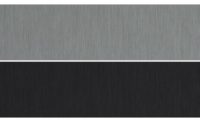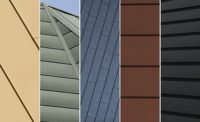Building teams are increasingly being asked to examine the carbon footprint as they evaluate materials and products to meet projects’ performance requirements and code compliance. For wall cladding and roofing systems, architectural zinc’s inherent metallic properties can help reduce buildings’ operational carbon footprints, and improve their energy-efficient, climate-resilient, long-lasting performance.
Carbon Concerns
Carbon emissions, specifically emissions of carbon dioxide (CO2), are identified as greenhouse gases (GHGs). GHG emissions typically are measured in terms of “carbon equivalent” (CO2eq) and Global Warming Potential (GWP). A 100-year GWP is standard, which represents the energy absorbed by a CO2eq GHG over 100 years.
The internationally recognized Reporting Standard by Greenhouse Gas Protocol categorizes emissions reporting into three “scopes.”
- Scope 1 are direct emissions associated with the consumption of fuel, including transportation, equipment operation and facility operation.
- Scope 2 are indirect emissions associated with purchased energy for electricity, heating and cooling.
- Scope 3 are indirect emissions for activities not included in Scope 1 or 2 that are listed in 15 categories, including waste generated in operations and end-of-life treatment of sold products.1
Building teams have the opportunity to help significantly lower GHG emissions across all three scopes.
The Carbon Smart Materials Palette, an Architecture 2030 Project that provides attribute-based design and material guidance, stated, “It is anticipated that embodied carbon will be responsible for 72 percent of the carbon emissions associated with global new construction between now and 2030.” 2 Considering a typical building is in use for 50 to 100 years, the projects being designed and constructed today will be completing their operational lifecycles around 2073, and into the 2120s.
Material transparency allows building teams to make more informed decisions. Assisting with evaluation, manufacturers can provide life cycle assessments (LCAs), environmental product declarations (EPDs), Cradle to Cradle certifications and other documentation. Where industry average EPDs and other data previously was acceptable, product-specific and facility-specific data are increasingly requested for more accurate selection criteria and project sustainability reporting.
Carbon-Reduced, High-Quality Zinc
A natural metal, zinc is the 24th most abundant element in the Earth’s crust and the fourth most-used metal in the world.3 For architectural applications, raw zinc material is smelted, cast as a material of uniform and certified quality, and wound as a coil in one continuous operation. Rolled zinc sheet is produced by alloying Special High-Grade (SHG), 99.995 percent pure zinc with minute quantities of copper, titanium and aluminum. The alloy composition provides the material the necessary strength, while allowing the architectural product to be easily shaped.
As material demands and energy costs rise, energy-efficient production maximizes both economic and environmental resources. Because zinc has a low melting point of 784 degrees Fahrenheit, it takes less energy to process it than other metals and materials. For comparison, aluminum melts at 1220F and steel at 2500F.
The International Zinc Association (IZA) provides practical guidance on calculating the carbon footprint for SHG zinc in compliance with ISO 14040 and 14044, as well as with the Product Life Cycle Accounting and Reporting Standard by Greenhouse Gas Protocol.4 As a global average, the carbon footprint GWP for primary SHG zinc production was calculated by the IZA to be 3.64 kg CO2eq per 1 kg (8.02 lbs. CO2eq per 1 lbs.).5 Many IZA member companies have committed to climate change policies to reach net-zero Scope 1 and 2 GHG emissions by 2050. An increasing number also are working on Scope 3 targets.6
One IZA member7 has further lowered the carbon footprint of its SHG zinc product to achieve a 100-year GWP of 1.85 kg CO2eq per 1 kg (4.08 lbs. CO2eq per 1 lbs.). This savings was gained through energy-efficient production practices that rely on electricity largely generated from renewable sources including water and wind power. Additionally, recycled zinc material is used in its production. This investment reduced the product’s impact by 54 percent and saves more than 36,000 metric tons (39,283 U.S. tons) of CO2eq each year, equivalent to the GHG emissions of a small town with 5,400 people. Quantifying this, a 1 m2 area of standing-seam zinc material would have 12 kg CO2eq (26.5 lbs. per 10.8 ft2). This low-carbon architectural zinc material is now available in North America.
Composition, Patination, and Installation
In North America, ASTM B69-21, “Standard Specification for Rolled Zinc,” is the primary reference document for Type 1 and Type 2 Architectural Rolled SHG zinc alloys and their expected characteristics.8 The zinc alloy composition determines the metal’s coloration. Type 1 tends toward blue-gray and Type 2 contains slightly more copper (0.80-1.00 percent), which produces more of a graphite-gray coloration.
Untreated, architectural-grade zinc looks bright, shiny and light reflective. Over time, a natural matte patina develops, creating a dynamic appearance as the material ages. A patina’s formation is a process of the gradual growing together of zinc carbonate “freckles.” The rate of its formation is related to the slope of the surface. The patina will form slower on a vertical wall surface than on a slightly pitched roof. The patination speed varies between six months and five years or more, depending on climatic conditions. The more exposure to wetting and drying cycles, the quicker the patina will develop.
Some manufacturers offer pre-weathered zinc material that accelerates the patina formation under controlled conditions. Factory-finished options are also available to achieve an initial, uniform aesthetic. Typically, these finishes are painted or phosphate architectural coatings applied in the factory under environmentally controlled conditions.
Architectural zinc coils are unwound, cut and fabricated into panels, tiles and other formed exterior architectural products. Because zinc is a lightweight material, it can help reduce the structural load and associated materials on a building. Qualified contractors install zinc products as wall cladding and roof systems, gutters, downspouts and more.
Climate-Resilient, Long-Lived Performance
Architectural zinc has been used in coastal communities for generations and can be seen on building projects across many climate zones. Installed properly, zinc building systems will resist air and water infiltration, and withstand high winds reaching up to 150 mph.
Zinc’s natural patina will appear lighter when used in marine locations where the air contains chlorides (salt). Deposits will not be as visible on lighter blue-gray zinc. For aesthetic reasons, it is recommended to clean the surface of the material with clean water (not seawater) at least twice a year in maritime climate zones, depending on local conditions. If the metal is scratched, scuffed or fingerprinted, zinc will heal itself by re-patinating. With time and exposure to wetting and drying cycles, the former blemish will patinate and blend to match.
In areas facing multiple climate challenges, such as marine environments that are susceptible to wildfires, architectural zinc offers a noncombustible solution. It also is noncorrosive. Research from the Association for Materials Protection and Performance estimates the cost of corrosion to the U.S. construction industry at $50 billion.9
Along with zinc’s climate-resilient, noncorrosive performance, it also provides a long lifespan to support reduced-carbon sustainable design and operational goals. Reduced-carbon architectural zinc wall cladding, roofing systems and other building materials have a lifespan of 100 years or more.
In the U.S., asphalt has been the dominant material for roofs. Primarily made from petroleum, asphalt is a high-carbon material. The lifespan of an asphalt roofing is approximately 20 years.10 While the initial material purchase price of asphalt is less expensive, over the lifetime use of the roof, architectural zinc costs less.11
Replacing a roof not only is a material and labor expense, but it also disrupts the property’s operation and occupants, resulting in lost productivity. Rooftop photovoltaic (PV) arrays have a lifespan of approximately 25-30 years for residential properties and longer for more robust commercial buildings systems.12 This means during a PV array’s lifetime use, an asphalt roof would need to be replaced at least once, interrupting renewable solar energy power generation. A zinc roof provides a platform to mount solar panels without replacing the roof, and will outlast the PV array’s lifespan.
In addition to accommodating power-generation systems, gutters and downspouts fabricated from architectural zinc offer decades of continuous use in rainwater collection and harvesting systems. Its run-off is non-staining and non-toxic.
During their many years of use, zinc building products do not rot, rust or need repainting. No paint, varnish or sealants are required. Architectural zinc products require very little maintenance, repair or replacement, which further lowers their associated economic and environmental costs.
At the end of its long life of use on a property, the zinc material can be recycled 100 percent without degradation to its performance properties. Sixty percent of all zinc produced is still in use and 45 percent of all zinc produced is recycled. Globally, 95 percent of rolled zinc sheet is recycled.13
The sustainable attributes and applications of architectural zinc products support criteria for several green building programs including the U.S. Green Building Council’s LEED rating system, and the Cradle to Cradle Products Innovation Institute’s certification system. Products that have earned Cradle to Cradle certification demonstrate: no release of any toxic substances during usage, deconstruction and recycling; retainage of original properties without loss of performance; and re-useability as a new item of at least equal value.15
Support and Call to Action
Climate change is a worldwide issue and actions to limit its effects are global undertakings. Supporting climate-resilient action, the U.S. Inflation Reduction Act (IRA) of 2022 is investing $369 billion to modernize the U.S. energy system and—in combination with the Bipartisan Infrastructure Law of 2021, other enacted policies and past actions—to drive 2030 economy-wide GHG emissions to 40 percent below 2005 levels.15
The IRA expected emissions reductions anticipated by 2030 total nearly 1,150 million metric tons (2.5 quadrillion lbs.) CO2eq, equivalent to the approximate combined annual emissions released from every home in the United States. The U.S. Department of Energy expects the pollution reductions from these provisions to increase across all sectors beyond 2030, ensuring continued progress toward the nation’s 2050 net-zero emissions goal.16
The 2030 Challenge proposes all new buildings, developments, and major renovations to be carbon neutral by 2030. This challenge has been adopted by 73 percent of the 20 largest architecture/engineering firms, responsible for more than $100 billion in construction annually.17
Building teams have a unique role in mitigating climate change and its effects through selecting materials, products and practices that reduce both operational and embodied carbon. Architectural zinc material and product manufacturers can offer support and sustainable solutions.
In North America, architectural zinc is available as manufactured with energy-efficient, low-carbon processes, validated with product-specific documentation. Installed as wall cladding and roofing systems, architectural zinc supports climate-resilient, low-maintenance performance, and occupants’ safety and health. With a lifespan of 100 years or more, architectural zinc saves time, material and money. Infinitely recyclable, zinc continues to add value beyond the life of the building.
References
1. World Resources Institute & World Business Council for Sustainable Development, Greenhouse Gas Protocol: Technical Guidance for Calculating Scope 3 Emissions, Version 1.0, 2013, https://ghgprotocol.org/sites/default/files/ghgp/standards/Scope3_Calculation_Guidance_0.pdf, accessed July 6, 2023
2. Carbon Smart Materials Palette, an Architecture 2030 Project, “Why Embodied Carbon?” https://materialspalette.org/, accessed July 6, 2023
3. International Zinc Association (IZA) “Environment – Zinc is Natural,” https://www.zinc.org/environment-2/, accessed July 6, 2023
4. IZA, “Carbon Footprint Guidance,” https://www.zinc.org/carbon_footprint_guidance/, accessed July 6, 2023
5. IZA, “Life Cycle Assessment,” https://www.zinc.org/life-cycle-assessment/, accessed July 6, 2023
6. IZA, “Climate Change,” https://www.zinc.org/climate_change/, accessed July 6, 2023
7. RHEINZINK, “prePATINA Eco Zinc,” https://www.rheinzink.com/products/materials-surfaces/prepatina-eco-zinc/, accessed July 6, 2023
8. ASTM B69-21, “Standard Specification for Rolled Zinc,” https://www.astm.org/b0069-21.html, accessed July 6, 2023
9. Association for Materials Protection and Performance, “Economic Impact,” http://impact.nace.org/economic-impact.aspx, Appendix A: Assessment of Global Cost of Corrosion, Dec. 23, 2015, impact.nace.org/documents/appendix-a.pdf, accessed July 6, 2023
10. American Chemical Society, Chemical & Engineering News, “What’s That Stuff? Asphalt,” Michael Freemantle, Vol. 7, No. 42, Nov. 22, 1999, http://pubsapp.acs.org/cen/whatstuff/stuff/7747scit6.html, accessed July 6, 2023
11. Consumer Reports, “Roofing Buying Guide,” April 3, 2023, https://www.consumerreports.org/home-garden/roofing/buying-guide/, accessed July 6, 2023
12. PV Magazine, “How Long Do Rooftop Residential Solar Panels Last,” Ryan Kennedy, Sept. 27, 2022, https://pv-magazine-usa.com/2022/09/27/how-long-do-rooftop-residential-solar-panels-last-2/, accessed July 6, 2023
13. IZA, “Circularity,” https://www.zinc.org/circularity-2/, and “2050 Demand Supply,” https://www.zinc.org/wp-content/uploads/sites/30/2022/10/2050-Demand-Supply_VF_11_22.pdf, accessed July 6, 2023
14. Cradle to Cradle Products Innovation Institute, https://c2ccertified.org/, accessed July 6, 2023
15. United Nations Environmental Programme, Emissions Gap Report 2019, https://www.unep.org/interactive/emissions-gap-report/2019/, accessed July 6, 2023
16. U.S. Department of Energy, Office of Policy, “The Inflation Reduction Act Drives Significant Emissions Reductions and Positions America to Reach Our Climate Goals,” Aug. 2022, https://www.energy.gov/sites/default/files/2022-08/8.18%20InflationReductionAct_Factsheet_Final.pdf, accessed July 6, 2023
17. Architecture 2030, “How widely adopted is the 2030 Challenge?” https://architecture2030.org/about/faq/#toggle-id-3, accessed July 6, 2023
.jpg?t=1691680853&width=1080)




